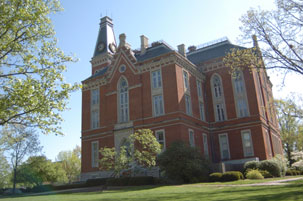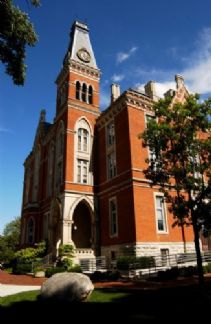DePauw Extends Capital Campaign and Raises Goal to $300 Million
October 9, 1998
 October 9, 1998, Greencastle, Ind. - The DePauw University Board of Trustees, at its October meeting, raised the goal in the Campaign for DePauw: Leadership for a New Century to $300 million and extended the length of the Campaign by two years. The Campaign, publicly launched two years ago, had an initial goal of $153 million and was scheduled to end in 2000. National Chair of the Campaign, Andrew J. Paine, Jr. of Indianapolis, reported to the trustees the current total of commitments exceeds $195 million.
October 9, 1998, Greencastle, Ind. - The DePauw University Board of Trustees, at its October meeting, raised the goal in the Campaign for DePauw: Leadership for a New Century to $300 million and extended the length of the Campaign by two years. The Campaign, publicly launched two years ago, had an initial goal of $153 million and was scheduled to end in 2000. National Chair of the Campaign, Andrew J. Paine, Jr. of Indianapolis, reported to the trustees the current total of commitments exceeds $195 million.
"Cognizant of the unprecedented opportunity we have to advance DePauw in both effectiveness and reputation, and with heartfelt gratitude to the donors who have brought us to this historic juncture," as trustees said in their resolution, the board voted to nearly double the original target of the campaign.
"This increased campaign goal is one of the largest ever undertaken by a liberal arts institution of DePauw's size," Paine remarked, after the trustees' unanimous vote.
According to Timothy H. Ubben of Chicago and chair of the Board of Trustees, the primary reason trustees have taken this step is "to claim a once-in-a-lifetime opportunity to move DePauw to a new level of both quality in its educational experience and its reputation for that quality." He continued, "The administration and faculty leaders have proposed an impressive list of areas for investment including faculty compensation, faculty development, new initiatives to strengthen academic departments and programs, implementation of a powerful new first year experience for students, improvements in instructional uses of technology, additions to campus facilities, and recruitment of the very finest students DePauw can attract."
At the meeting of the Trustees, President Robert G. Bottoms further described the "areas for investment" which additional resources could support. Extending the campaign would enable the University community to consider "a new, larger vision of DePauw's future." These potential resources should include investments to add strength to an already superior faculty, Dr. Bottoms said. DePauw seeks to fund an extensive new faculty development program, which would facilitate the hiring of experienced "teacher-scholars" in addition to newly graduated Ph.D.s.
The program would also make available 30 to 35 faculty fellowships, comprising both a stipend and released time for projects that would enhance the teaching and scholarship of current faculty. In addition, a more expansive plan available for senior faculty members to be called University professorships is being proposed. A third component of the faculty development plan, to endow visiting professorships, President Bottoms said, would give the University an  opportunity to bring nationally recognized scholars to campus for a semester or year.
opportunity to bring nationally recognized scholars to campus for a semester or year.
One of the opportunities for investment with the highest potential, Dr. Bottoms said, is the design and implementation of a distinctive first year experience for students. Calling it a nine-month "window of opportunity" to develop students' commitment to intellectual pursuits, to help them shape their values, and to strengthen their bonds to the University, he praised the initial work of a committee of faculty, staff, and students which was formed this fall to develop a framework for a comprehensive shift in academic and co-curricular programs and priorities.
"The expanded vision for DePauw's leadership in a new century," President Bottoms said, "most certainly includes students -- they are always the focus of our purpose." He also described how endowment dollars to underwrite campus social programming would benefit all students. "While much has been done to bolster endowment for scholarships," he said, "we still must work to make sure the total DePauw experience can attract the top students in our pool of applicants."
Outlining other opportunities to enhance both the academic and campus life of the University, Dr. Bottoms also noted several capital projects which were not among the goals of the initial campaign but were on the University's list of long range priorities. The extended goals included the building of a new instructional facility for the Art Department which has outgrown its teaching and studio space, the expansion and transformation of the Julian Math and Science building into a state of the art technology center and planetarium, and construction of an indoor tennis and track facility near Blackstock Stadium. Also proposed in the new campaign goals is a very needed study on the eventual improvement of the library and its collections. "The University must equip its library with 21st century resources for learning and scholarship by students and faculty," he said.
The administration estimated the total resources for these strategic investments in both programs and facilities at more than $100 million. "Where does this take DePauw University four years from now?" the President asked, anticipating questions of alumni and friends. If we make these investments in faculty, students, and the programs and facilities in which they work together, we can be absolutely certain that we will challenge students intellectually and inspire them to leadership and service as well as any liberal arts college in the nation."
for these strategic investments in both programs and facilities at more than $100 million. "Where does this take DePauw University four years from now?" the President asked, anticipating questions of alumni and friends. If we make these investments in faculty, students, and the programs and facilities in which they work together, we can be absolutely certain that we will challenge students intellectually and inspire them to leadership and service as well as any liberal arts college in the nation."
Mr. Paine added, "The Campaign Executive Committee is confident that, in view of the magnitude of the opportunities we have and motivated by the vision we share for DePauw, alumni and friends will, in addition to their Annual Fund gifts, continue to make generous commitments to DePauw."
Chairman Ubben said the recommendations would be considered carefully in discussions with the campus community over the next three months, with alumni leaders across the country and also with members of a newly formed Strategic Planning Committee of the Board.
Back